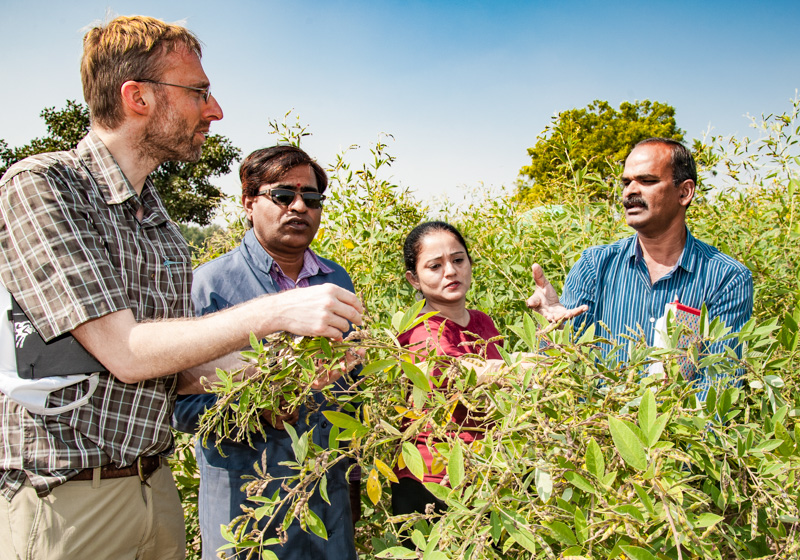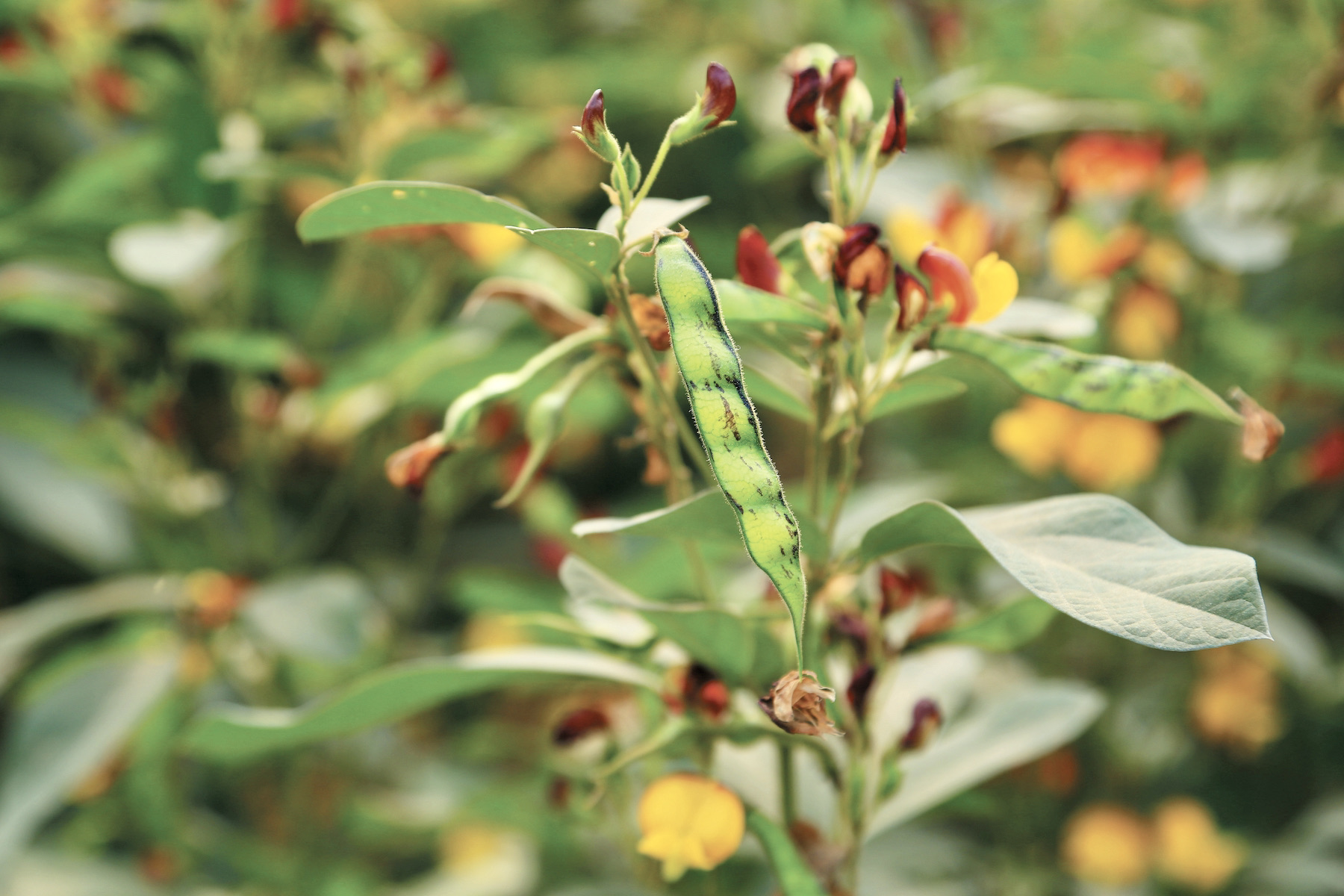Pigeonpea
Why pigeonpea?
Pigeonpea [Cajanus cajan (L.) Millsp.], the sixth most important edible legume crop, is grown on about 6 million hectares worldwide. India, Myanmar, Malawi, Tanzania and Kenya are the world’s top pigeonpea producers.
Pigeonpea makes a significant contribution to human and animal nutrition. It is the main source of protein for the vegetarian population across the globe.
It is tolerant to dry and hot weather conditions and is thus an important crop in the semi-arid tropics. Its cultivation improves soil health owing to its ability to fix atmospheric nitrogen and enrichment of soil organic carbon. The narrow genetic base of cultivated pigeonpea and the lack of high level of resistance/tolerance to important biotic/abiotic stresses hinders its genetic improvement. Yields have been stagnant at about 800 kg/ha for the past six decades.
What we achieved
Collecting
- 30 seed samples of four pigeonpea wild relatives (C. scarabaeoides, C. mollis, C. crassus and C. goensis) were collected from three countries: Nepal, Pakistan and Vietnam.
Pre-breeding and evaluation
- Advanced-generation pre-breeding populations were developed through crossing wild Cajanus species from secondary (C. cajanifolius, C. acutifolius, C. scarabaeoides) and tertiary (C. platycarpus) gene pool with established cultivars of pigeonpea.
- Fifty-five promising pre-bred lines incorporating traits from pigeonpea wild relatives were developed, comprising 12 with high yield, 20 with tolerance to salinity and 23 with disease resistance. Thirty-nine pod-borer tolerant ILs were also identified.
- These introgression lines (ILs) were evaluated at four sites in India and across locations in Myanmar. Six promising high-yielding ILs were also evaluated in the farmers’ participatory varietal selection trials in locations across India.
- Several promising high-yielding ILs were included in the Initial Varietal Testing of the All India Coordinated Research Project on Pigeonpea during 2018-19 and 2019–20 rainy seasons. One was included for the first time in multilocation trials in the Telangana State during the 2019–20 rainy season, while two others were included for the second year.
- Eight pre-breeding populations are conserved in medium-term cold room of Theme Pre-breeding at the International Crops Research Institute for the Semi-Arid Tropics (ICRISAT), Patancheru, India and available for sharing through the Standard Material Transfer Agreement (SMTA).
- Four promising ILs derived from wild species are conserved in the R.S. Paroda genebank at ICRISAT, Patancheru and available for sharing through SMTA.
- Four ILs derived from wild species have been given a national identity number and are conserved in the National Bureau of Plant Plant Genetic Resources (NBPGR), New Delhi, India, and are available for sharing through SMTA.

Regional Agricultural Research Center of the Professor Jaya Shankar Telegana State Agricultural University in Warangal. Pre-breeding project ‘Identification of superior alleles and lines from wild Cajanus species for pigeonpea improvement’. Photo: Michael Major/Crop Trust
Project partners
Collecting
- National Agriculture Genetic Resources Center, Khumaltar, Nepal
- Plant Genetic Resources Program, Bio-Resources Conservation Institute, Islamabad, Pakistan
- Plant Resources Center, Hanoi, Vietnam
Pre-breeding and evaluation
Lead Institute: ICRISAT, Patancheru, Hyderabad, India
Partners:
- Professor Jayashankar Telangana State Agricultural University (PJTSAU), Hyderabad, India
Regional Agricultural Research Station (RARS), Warangal, Telangana, India
Regional Agricultural Research Station (RARS), Palem, Telangana, India - Acharya N G Ranga Agricultural University, Guntur, Andhra Pradesh, India
Regional Agricultural Research Station (RARS), Tirupati, Andhra Pradesh, India - Department of Agricultural Research, Yezin, Myanmar
Pigeonpea key collections, materials and data
Pigeonpea collections
- The largest pigeonpea collection is conserved at ICRISAT, Patancheru, India.
- The Genesys PGR database also includes information about pigeonpea accessions in genebanks worldwide.
- New accessions of C. scarabaeoides, C. mollis, C. crassus and C. goensis collected from Nepal, Pakistan and Vietnam are conserved in the National Agriculture Genetic Resources Centre, Nepal, the Bio-Resources Conservation Institute, Pakistan and the Plant Resources Center, Vietnam for sharing following the SMTA.
Pre-breeding materials
- All pre-breeding materials are conserved in the cold rooms of the pigeonpea breeding program at ICRISAT, Patancheru, India
- Promising ILs are conserved in R.S. Paroda genebank at ICRSIAT, Patancheru, India and in the NBPGR, New Delhi, India.
Data
- All data from the pigeonpea pre-breeding and evaluation projects are available in the Germinate pigeonpea database.
Pigeonpea stories
Crop Trust stories
- Taming the wild pigeonpea. https://www.cwrdiversity.org/pigeonpea_pre-breeding/. 11 May 2018.
Partner stories
- Distant cousins of domesticated crops harbor traits to feed a hungry planet. Agri-buzz. http://www.icrisat.org/distant-cousins-of-domesticated-crops-harbor-traits-to-feed-a-hungry-planet/. 28 February 2018.
- Wilder and stronger: India-Myanmar pigeonpea program gets new research boost. https://www.icrisat.org/wilder-and-stronger-india-myanmar-pigeonpea-program-gets-new-research-boost/. 25 October 2018.
- Multilocation evaluation of six pigeonpea pre-breeding lines through India’s national program. https://www.icrisat.org/multi-location-evaluation-of-six-pigeonpea-pre-breeding-lines-through-indias-national-program/. 19 July 2019.
Relevant publications
- Khoury, C.K., Castañeda-Alvarez, N.P., Achicanoy, H.A., Sosa, C.C., Bernau, V., Kassa, M.T., Norton, S.L., van der Maesen, L.J.G., Upadhyaya, H.D., Ramírez-Villegas, J., Jarvis, A., Struik, P.C. 2015. Crop wild relatives of pigeonpea [Cajanus cajan (L.) Millsp.]: Distributions, ex situ conservation status, and potential genetic resources for abiotic stress tolerance. Biological Conservation 184: 259–270.
- Sharma, S. and Upadhyaya H.D. 2016. Interspecific hybridization to introduce useful genetic variability for pigeonpea improvement. Indian J Genet & Pl Breed. 76: 496-503.
- Sharma, S. and Upadhyaya, H.D. 2016. Pre-breeding to expand primary genepool through introgression of genes from wild Cajanus species for pigeonpea improvement. Legume Perspectives Special Issue 11: 17-20.
- Sharma, S. 2017. Pre-breeding using wild species for genetic enhancement of grain legumes at ICRISAT. Crop Science 57: 1132–1144.
- Sharma, S., Paul, P., Kumar, C.V.S., Rao, J.P., Prasanthi, L., Muniswamy, S., Sharma, M. 2019. Evaluation and identification of promising introgression lines derived from wild Cajanus species for broadening the genetic base of cultivated pigeonpea (Cajanus cajan (L.) Millsp.). Frontiers in Plant Science 10: 1269. doi.org/10.3389/fpls.2019.01269
- Sharma, S., Paul, P.J., Sameer Kumar, C.V., Nimje, C. 2020. Utilizing wild Cajanus platycarpus, a tertiary genepool species for enriching variability in the primary genepool for pigeonpea improvement. Frontiers in Plant Science 11:1055. https://doi.org/10.3389/fpls.2020.01055.
- Hussain, M,E,, Sharma, S., Joel, A.J. and Kilian, B. 2022. Photoperiod insensitivity in pigeonpea introgression lines derived from wild Cajanus species. Agronomy 12, 1370. doi.org/10.3390/ agronomy12061370
- Sharma, S., Jaba, J., Rao, P.J.M., Prasad, S., Gopal, N.T.V.V., Sharma, H.C. and Kilian, B. 2022. Reaping the potential of wild Cajanus species through pre-breeding for improving resistance to pod borer, Helicoverpa armigera in cultivated pigeonpea (Cajanus cajan (L.) Millsp.). Biology 11(4): 485. Doi: 10.3390/biology11040485

